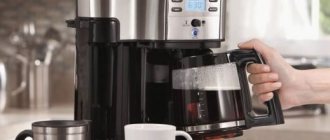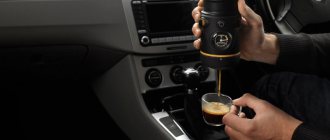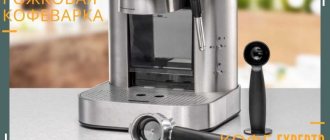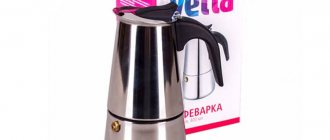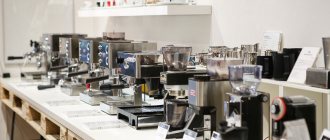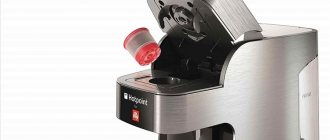Coffee machines have long gained a strong position in many families. With a lack of free time, the speed of preparing coffee within 1-2 minutes is crucial for many. Correct use of the device affects the taste of the finished drink. Therefore, to obtain the desired result, it is recommended to know the general structure and operating principle of the coffee machine.
Types of coffee machines
All coffee machines differ from each other in design and functionality. They can be equipped with a cappuccino maker and perform almost all necessary operations automatically. According to their qualities, coffee machines are divided into several categories:
- Standard coffee machines . As a rule, these cars are included in the budget segment. Most of them do not have a cappuccino maker, so drinks with milk cannot be prepared. Almost all have built-in coffee grinders, which distinguish coffee machines from regular coffee makers.
- With manual cappuccino maker . This function is performed by a separate tube equipped with a special nozzle for supplying hot steam. The panarello nozzle expands the steam stream, accelerating the formation of foam. The main disadvantage is the need to manually froth the milk. Although this process is quite easy, it is time consuming. Thus, in these coffee machines, the foam is first created manually, and only after that it is used for its intended purpose. However, coffee machines with a manual cappuccino maker allow you to save a lot of money when purchasing, especially when you plan to prepare dairy drinks not very often.
- With automatic cappuccino maker . These are already more advanced and functional coffee machines. The required dosage of milk is determined and measured automatically. It is possible to select the sequence of mixing cappuccino ingredients. The only manual action is to move the cup of coffee under the frothed tube. In many machines, the milk container is made removable and stored in the refrigerator until ready.
- Superautomatic machines . The most expensive machines capable of preparing the most delicious coffee drinks. Wide functionality covers almost all work processes and brings them into automatic mode. The coffee beans are only poured in manually, water and milk are poured in. After this, the required mode is selected and all that remains is to wait for the final result. All containers for grains and liquids are large and do not require frequent refills. In expensive and professional models you can even prepare hot chocolate and other exotic products.
Choosing a coffee machine for home use
Before purchasing a coffee machine for your home, you should conduct a comparative analysis of various model solutions according to the following parameters:
- Focus on a specific type of drink. If all family members prefer a specific type of coffee, then the equipment should be selected based on this requirement. For example, a drip coffee machine is not capable of preparing aromatic, rich enough espresso. On the contrary, if you don’t like a strong drink, and in most cases they brew Americano, it makes no sense to pay extra for unused functions.
- Performance. Not only the speed of processing ingredients, but also the productivity of operation depends on this parameter. The more productive the device, the more it uses electricity. You need to choose the optimal power taking into account individual needs. An indicator of 2 kW, and sometimes slightly less, is quite acceptable for using a coffee machine at home.
- Water tank capacity. The number of portions of one working cycle depends on this value. You must choose a container so that it is enough to brew a drink for strictly one serving. If only two people in the family drink coffee, then a 500 ml container should be enough.
- Trademark. A coffee machine is exactly the option when the manufacturer is important. The leading companies in this segment are rightfully considered to be Maxwell, Bialetti, Bosch, Krups, Saeco and Nespresso. Private brands produce coffee brewers of average quality, and the coffee produced from them has low taste characteristics. In addition, such a device will not last long.
Drip coffee maker device
Drip coffee makers have been known since the beginning of the 19th century. In these primitive devices, hot water gradually passed through coffee powder. Subsequently, the device was modernized many times, its structure was improved, but the main components and principle of operation remained unchanged. With the advent of electrical appliances, coffee makers also underwent changes. They acquired their own heating element and a more familiar external design.
The best drip coffee makers for home - TOP 15
The drip coffee maker consists of the following elements:
- Container for cold water. It is located in the back and in most models is non-removable.
- A boiler is a metal vessel in which water is heated.
- Heating element located inside the boiler.
- Funnel with filter. Designed to hold coffee powder. Different models may be removable or non-removable.
- Coffee pot for the finished drink. Manufactured in various shapes and configurations.
A coffee maker that makes the right espresso
It was at the La Pavoni SPA plant that they improved the basic model, but most importantly, they found out that the drink acquires optimal taste if it is prepared under a pressure of 9 bar and in a temperature range from 86 to 92 degrees. If the heating temperature is lower, the extraction will be insufficient for espresso and the coffee will be sour. Above that, too many tannins and astringents will get into the drink, and the coffee will taste unpleasantly bitter.
In the mid-forties, the famous Achil Gaggia, the future founder of the Gaggia company, came up with the idea of equipping the device with a specially designed lever. It was its use that allowed the espresso to be decorated with that very nutty crema foam that gave the drink sophistication and a special charm.
In 1961, the Italian company Faema released a model in which pressure was created using an electric pump pump. Thus began the era of pump-action espresso coffee makers.
Since the 60s of the last century, there have been no more constructive breakthroughs from changes.
The entire further history of espresso coffee makers is an improvement of the form factor and expansion of functionality.
How does a drip coffee maker work?
The operating principle of the coffee maker is very simple. The entire cycle consists of the following operations:
- Cold water is poured into the reservoir, which is located at the back of the device. From here it is fed from top to bottom into the boiler.
- Here the water is heated, after which it rises up through a special tube.
- Gradually, in the form of drops, it passes through the ground coffee.
- Next, the water converted into coffee is collected in the bottom vessel for the finished product.
- Upon completion of the entire cycle, the drink is considered ready for consumption.
The entire mass of coffee grounds is retained inside the filter. This keeps the cups clean. The drink temperature can be maintained for a set time. This is ensured by the heating function of the area where the coffee pot is located.
The general operating principle is used by all manufacturers. Otherwise, products may differ significantly in performance, power, design and other features.
French press coffee maker design
The coffee machine, which operates on the principle of a French press, is a teapot made in the form of a glass flask with a handle. In addition, the design separately includes a manual press and a metal filter. The French press is very popular among domestic consumers. Basically, tea is brewed in it, but this device is also successfully used for making coffee.
All flasks are produced with the same internal diameter. Different models differ only in their height, which determines their capacity. A taller reservoir holds a larger volume of liquid. The glass of the flask is highly durable and resistant to high temperatures. The main body can be decorated with steel or plastic elements. Many models have a beautiful metal cup holder.
The lid has a hole for a rod on which a press is attached that squeezes out tea leaves or coffee powder. The piston is equipped with a special mesh filter that fits tightly to the glass walls.
In general, the device has gained popularity due to its low cost. It is easy to maintain and is suitable not only for making tea or coffee. With its help you can obtain natural juice from fruit pulp, make cocktails, etc.
Differences between coffee makers and coffee machines
Quickly preparing delicious coffee is the main function of any coffee makers and coffee machines. Despite this similarity, there are differences in the ways these devices implement the main task .
Important! Unlike a coffee maker, a coffee machine has impressive dimensions and has expanded functionality, which is why the price of the device is much higher and the control is more difficult.
The device is capable of performing everything from grinding coffee beans just before brewing to heating and filling several cups .
Some models of coffee machines can synchronize with a smart home system and prepare a drink based on a signal received through a mobile application. Coffee makers, in turn, are distinguished by reasonable prices, compact sizes, limited functionality, and a variety of designs and models .
The advantages of coffee makers also include a low noise level , because compared to a coffee machine, the machine practically does not make any sounds while preparing coffee and, most likely, will not cause all family members to wake up early.
Attention! Large volumes and high performance make the coffee machine an excellent option for offices, coffee shops and bars, however, for home use, the best option would be a coffee maker - a compact and convenient device that can prepare an equally tasty drink.
How does a French press work?
There is nothing complicated about the work of a French press. All actions are performed in several stages:
- Water must be boiled in advance in the required quantity.
- If the coffee beans are ground, they need to be ground in a coffee grinder. It is advisable to use the device with ceramic knives so as not to spoil the grains.
- The finished powder is poured inside a glass flask. For the 1st cup, one teaspoon of coffee is required.
- After this, boiling water is poured into the flask based on the number of servings.
- The coffee is stirred and left in this form for 3-5 minutes. During this time, the water will absorb all the aromatic and beneficial properties.
- Next, the press slowly lowers down under the pressure of the hand. The filter moves evenly along the walls. During the movement, the grounds are separated from the finished drink, and the purified coffee can be poured into cups.
Geyser coffee maker device
The design of the geyser coffee maker includes two containers. One of them serves as a water reservoir and is the base. The other - accumulative - is intended for collecting the finished product. An equally important third part is the funnel filter. Coffee powder is poured into it, after which the filled element is inserted into the lower reservoir.
The upper tank is equipped with a removable filter. The place of contact with the lower container is separated by a silicone or rubber gasket. A metal tube is placed in the internal space, the end of which is directed upward.
Emergency steam release at elevated pressure is carried out through a safety valve installed in the side wall. Therefore, you cannot pour water above it. For the convenience of pouring the finished drink, the upper part of the coffee maker is equipped with a special spout. Opposite it, at the back, there is a handle that is resistant to high temperatures.
Purover
The pour-over method of making coffee is compared to the tea ceremony in terms of entertainment. Medium grind coffee is used for brewing. You will need equipment from Hario: a pour-over funnel, into which a filter made of paper, fabric or fine metal mesh is placed and coffee is poured. Water is heated in a kettle with a long and narrow spout. In a thin stream, moving in a circle, pour coffee powder onto the filter. The finished drink is collected in a container on which a filter is installed.
Purover
Another type of pourover is Kalita Wave. Having passed through a corrugated filter placed in a container with transverse grooves, the drink acquires a richer taste and aroma than that obtained from Hario pourover.
Kalita Wave
How does a geyser-type coffee maker work?
For the normal functioning of a geyser coffee maker, hot water and steam are required. Water is initially poured into the lower container. Here it is heated and partially converted into steam. It influences the boiling liquid and pushes it upward. The water rises, enters the filter with coffee powder, and absorbs its aroma and taste. Next, the finished coffee rises up the tube and is collected in the upper container.
Thus, obtaining a drink becomes possible under the influence of steam exerting pressure on heated water. The operation of a geyser coffee maker resembles the operation of a horn device. Therefore, if you follow the preparation rules, the strength and aroma of coffee will be in no way inferior to a coffee machine.
Preparing a drink in a geyser coffee maker is carried out in a certain sequence:
- The lower container is separated from the upper one, after which cold water is poured into it.
- The filter is filled with coffee powder to avoid excessive compaction.
- The prepared elements - the upper and lower parts - are connected to each other. After this, the entire structure is installed on a large fire of a gas stove. After the water boils and turns into steam, the fire gradually decreases and then turns off completely. Air escaping from the top container indicates the finished product is ready.
Capsule coffee maker device
The appearance of capsule coffee machines may vary significantly between different models. The range starts with the simplest budget coffee makers and ends with devices controlled via a smartphone.
However, the main structural elements are present in all machines:
- Cold water container located at the rear.
- Pump.
- A heating element.
- A hollow needle of small diameter. Hot water flows through it under pressure.
- A system that brews and discards the used capsule.
- Control block.
Hermetically packed capsules contain ground coffee beans in an amount of 5-9 grams. The packaging is made of aluminum or food-grade plastic. Sealed containers can be stored for two years without the product losing its original qualities. After the casing is pierced, all the aromas and flavors of the coffee are absorbed into the hot water, turning it into a finished drink.
Main types of coffee makers
To understand the depth of differences between different types of coffee machines, it should be noted that the price range in the segment of these devices varies on average from 500-700 rubles. up to 20-30 thousand rubles. At the same time, commercial built-in equipment is available for 80-100 thousand rubles. Of course, the cost can be influenced by design features, performance and set of functions, but how the coffee maker works ultimately determines the quality of the drink and some of the nuances of its preparation. The most common types of coffee machines include the following:
- Drip. One might say, a budget option that does not indulge in high performance and wide functionality.
- Geysernaya. This is also an inexpensive option for household use, but the properties of the finished drink are more attractive than drip devices.
- Rozhkova. A special feature of this model is the ability to press coffee under pressure, which expands the possibilities of preparing the drink.
- Capsule. The device is closest to professional coffee makers, although it also has household modifications.
Also, coffee making devices are semi-automatic and automatic. The second option, of course, looks more attractive, but experts do not recommend rushing to abandon traditional control schemes. Now you can take a closer look at the different types of coffee machines individually.
Operating principle of capsule coffee machines
The operation of the capsule coffee maker is very simple. The capsule is inserted into the container, and then all processes are carried out automatically.
The operating principle of the coffee machine is as follows:
- The cup is installed on the platform.
- The type of coffee drink is selected.
- Water is pumped from the container using a pump.
- Passing through the heating element, the water is heated to the required temperature without reaching a boil.
- The powder capsule is pierced at the top or bottom, depending on the model.
- Hot water is forced through a needle under high pressure through the coffee powder. Here it absorbs all the beneficial properties, after which it is poured into a cup or glass in filtered form.
- The waste container is ejected manually or automatically.
Possible problems and malfunctions
If water splashes out of the spout, it may be because the pressure is too high. To remedy the situation, you can disable the steam function.
If the coffee maker works intermittently, you need to check whether everything is fine with the voltage in the network. In addition, malfunctions can be caused by poor quality of connections and seals, this happens with cheap equipment.
If the milk does not froth well, most likely the problem is in its quality.
Try replacing it with something else. The problem may also be that it was not cooled enough, or the cappuccino maker was immersed too deep into it.
If your coffee smells like plastic, you need to run the water through the coffee maker several times and drain it.
Design of a carob coffee machine
Carob coffee makers got their name because of the special nest designed for filling and compacting coffee powder. The element itself is known as a horn or holder. The second name is used by foreign coffee lovers. Devices can be single- or double-horned. The latter refer to semi-automatic and high-volume automatic machines.
The main components of the device are:
- Water pump. It supplies water to the circuit, including the heating boiler.
- Boiler. This is where the water is heated to the desired temperature.
- Pressure switch and pressure sensor. They protect the boiler from rupture from excess pressure and overheating.
Externally, the horn resembles a strainer with a handle. Together with the coffee powder, it is inserted into the brewing group, where the water heated in the boiler is distributed. Steam enters a special spout and whips the milk to a thick foamy consistency.
Most machines come with a warming rack, a display, function buttons, and other useful controls. In general, this is too general and simple a description, since different models may have several holders, boilers and dispensing groups. They differ in case material and the presence of a variety of additional functions.
How to choose a carob coffee maker: we help you decide on the criteria
A coffee maker is perhaps the most popular and in demand device designed for preparing espresso and drinks that contain it.
By the way, according to the latest edition of ROS (Russian Spelling Dictionary), words denoting coffee drinks (espresso, cappuccino, latte) can be used both as masculine nouns and as neuter nouns. So now you don’t have to worry about making mistakes.
Carob coffee makers can be fairly roughly divided into several categories (or classes) - from the simplest (amateur) to professional equipment specially designed for use in catering establishments. Somewhere in the middle between them is the model that is most suitable for you personally. But identifying it among the entire assortment will not be so easy. And this despite the fact that all carob coffee makers, by and large, are designed approximately the same!
Inexpensive carob coffee maker Kitfort KT-722
The fact is that when it comes to preparing coffee, even small technological differences can lead to a significant change in the quality of the drink. Well, if you take into account that the topic of “proper coffee” is traditionally one of the “hottest” on the Internet forums, then opinions regarding a particular model can be completely different among different users. Even if we exclude overtly advertising or paid comments, the same device can “brew good coffee” from the point of view of a novice coffee lover and be “completely worthless” from the point of view of a slightly more advanced user.
How to make a choice and what to pay attention to first? Let's figure it out. But before we begin, let’s agree that our review is intended primarily for a “beginner” coffee lover who plans to become an “advanced” coffee drinker. We are confident that coffee professionals can understand the characteristic features of certain carob coffee makers without us.
Device of a carob coffee maker
As you might guess, the key difference between a carob coffee maker and all other coffee makers, Turks and other coffee gadgets is the presence of a horn. Ground coffee is placed in a cone, pressed into a tablet, and then hot water is forced through the coffee under pressure. This is how espresso is made. We'll talk about horns a little later, but for now let's deal with pressure.
Pump and pressure
The pressure in the carob coffee maker is built up using a pump. Just remember that classic espresso requires a pressure of 8-9 bar. Many coffee makers, even from the lower price segment, promise pressure of up to 15 bar or even more. However, in this case, more is not better. Even if this is not a marketing trick, this figure should be considered as “the maximum possible pressure” or “the pressure at the time the water leaves the pump.” By the time water enters the horn, its pressure will still be reduced to 7-9 bar.
Let’s immediately exclude pumpless (boiler) carob coffee makers from our review: devices that heat water and supply it to the carob naturally, without increasing pressure. As a result, the spill occurs under a pressure of 2-3 bar, which is clearly not enough to make espresso.
The vast majority of entry-level and mid-level coffee makers, as well as almost all household carob coffee makers, are equipped with a vibration pump that builds up pressure by oscillating a special piston (piston). The main disadvantage of such a pump is uneven pressure, which rises and falls with the movement of the piston. However, this cannot be called a serious drawback. The fact is that a normal vibration pump in most cases will be good enough for this class of coffee makers, and its impact on the quality of the finished drink will be disproportionately small compared to other technological simplifications and compromises. A vibration pump can be found in both the cheapest coffee makers (from 5,000 rubles) and quite expensive ones (150 thousand rubles or more).
Standard pump used in coffee makers of various brands - Krups, Delonghi, Rowenta, Saeco, Electrolux, AEG, etc.
In professional (industrial) coffee makers, a rotary pump is more often used, equipped with an electric motor, which rotates the water supply mechanism at a constant and constant speed. The resulting pressure is stable, but you have to pay for this with an increased price and significantly larger dimensions of the device.
True fans and coffee geeks may also remember lever coffee makers, in which the water pressure is adjusted manually, mechanically, using a special lever. In this case, the pump is essentially the person who makes the coffee. You won’t be able to accidentally buy such a coffee maker in a regular store, so we won’t focus on these devices. Let's just say that lever coffee makers provide maximum control over the preparation of the drink, but at the same time they require the highest possible skill from the barista.
Lever coffee maker Ponte Vecchio
How is water heated?
The second important element of a carob coffee maker is a device for heating water. After all, water temperature is the second most important parameter (after pressure) on which the quality of espresso depends. The more stable and close to ideal the temperature is, the better the drink will be. And vice versa - it is the inability of the coffee maker to produce water at the required and stable temperature that is most often the reason why espresso does not work, despite all efforts.
To heat water, a flow-through thermoblock, a storage boiler of small or large volume, or a boiler with a heat exchanger can be used. Entry-class coffee makers are equipped with a flow-through thermoblock or a small boiler (for home models, usually a little more than 100 ml). More “advanced” models have a large boiler (from 200-400 ml) or a boiler with a heat exchanger.
Let's list the pros and cons of each solution:
- Thermoblock - does not require preheating (allows you to supply hot water immediately and in any volume), but cannot provide a constant temperature - changes are possible;
- A small-volume boiler is compact, provides a small volume of water at the required temperature, but will require “reheating” after preparing even one serving of coffee;
- Large-volume boiler - will provide a larger volume of water at the desired temperature, does not require additional heating after preparing the first cup of coffee, but may spend more time on initial heating (when turning on the coffee maker after a long period of non-use);
- The heat exchanger is a system of tubes for supplying water located inside the boiler chamber. Water is heated as it passes through this coil. The water temperature turns out to be stable, but a lot of time will be spent heating the boiler, and after the initial heating, the heat exchanger will end up with overheated water, the temperature of which will be too high. It will just have to be drained into the pan (to carry out the so-called “idle spill”);
We'll put double-boiler coffee makers in a separate category: in such devices, one boiler is used for steam and the second for espresso.
Boiler with heating element for Delonghi 5/7/9 coffee maker
In most home coffee makers you will find a small boiler. Boilers of increased volume almost always mean that this model is at the very top among models of the entry class (or is already leaving it and belongs to the middle class).
Brew group and horn
Coffee extraction occurs in the brewing group, which includes a coffee horn with a filter and (usually) additional elements designed to improve the quality of the finished coffee.
Cheaper horns may use plastic. More expensive ones are made exclusively of metal.
The key element in the brewing group, on which the quality of the drink depends, is the filter (aka portafilter, aka basket). The simplest filter in design (and the most demanding for the barista’s skill) means that the coffee will flow “as is”, without any additional manipulations. The filter in this case will look like an ordinary fine mesh. Preparing coffee using such a “bottomless” filter will require certain qualifications (the ability to choose the right grind, tamp the coffee well, etc.). Without such skills, the drink will not turn out very well, to put it mildly.
All coffee makers designed for a wide range of users have filters with so-called “improvers” (this is what the Russian-speaking community began to call all kinds of systems designed to correct the mistakes of a novice barista, and correct the taste of espresso in case the barista made a mistake somewhere).
The design of the “improver” can be quite different: it is a filter with a double bottom (the first with many holes, the second with one), and multilayer filters with meshes, and even filters with springs that open the coffee supply when a certain pressure in the horn is reached. All of these “improvers” automate the process and prevent the user from doing something fundamentally wrong. On the other hand, the opportunity to intervene in the process also becomes less, which means that the improver will not allow you to brew exactly the espresso you want in the “manual control” mode.
Filter with “improver” included in the Redmond RCM-1511 kit
Fortunately, novice espresso lovers won’t have to think too much about the differences between “improvers”: in any case, the manufacturer does not allow you to choose an “improver” to suit your taste or replace it in the store, so the choice will be made automatically - at the time of purchasing one or another coffee maker.
“Bottomless” Dalla Corte portafilter costs almost $600
On our own behalf, we would recommend considering first of all portafilters made without the use of plastic or rubber seals. We also mention that the double-bottom filter may be difficult to clean if it is clogged with coffee that is too finely ground. However, all other filters will also have to be cleaned regularly, so this is unlikely to be a significant argument.
But what you can figure out easily and simply is the diameter of the horn. The rule “the more the better” almost always works here. The classic professional diameter is 58 millimeters. It is for such a horn that it will be easiest to purchase additional filters and portafilters (for replacement, or for experiments with higher-class filters). Home and budget coffee makers often have a horn with a diameter of 54 or even 50 millimeters.
Electronics and automation
There are not many options for automating the espresso preparation process with carob coffee makers. Without going into details, before choosing a carob coffee maker you should only inquire about the presence of two electronic components: an automatic water dosing system and a PID controller.
The automatic dosing system allows you to adjust the amount of water that the coffee maker will spill in one start. As a rule, there are two programs - for single and double espresso. The user is also given the opportunity to make changes (increase or decrease the volume of a portion of water) in order to best adjust the automatic mode to the favorite degree of coffee grinding (after all, the finer the grind, the slower the water will flow).
An electronic boiler temperature controller (aka PID) will ensure that the temperature of the supplied water is as stable as possible. The presence of such a device in a coffee maker is a sign of a middle or professional class, and you will have to pay significantly extra for the presence of a PID (usually several thousand rubles compared to a similar model without a controller).
Let us also mention such an important element as the three-way valve (solenoid). If equipped, the coffee maker will be able to release pressure from the brewing group immediately after stopping the water supply. The benefit of such a device is obvious - after the water supply is complete, there will be no residual drops dripping from the horn (a small thing, but annoying), and the coffee tablet itself will be significantly drier, which will facilitate the process of emptying the filter after the preparation of the drink is completed. Coffee makers with a solenoid also almost always belong to at least the middle class, and therefore will cost more than simpler models.
Gaggia Classic - a relatively inexpensive model with a solenoid “for the advanced hobbyist”
On the market you can also find carob coffee makers with automatic preparation of cappuccino or latte (by dispensing heated milk from a special container), however, we would prefer to classify these devices as automatic coffee machines and exclude them from the conversation about traditional carob coffee makers.
Redmond RCM-1511 with automatic milk supply
What about a coffee grinder?
When talking about choosing a carob coffee maker, one cannot help but think about a coffee grinder. The fact is that as the quality of the coffee maker improves, the issue of proper grinding of coffee beans becomes more and more important. And from a certain point (approximately at the transition from the initial to the intermediate level), the coffee maker simply will not be able to reveal all its capabilities without selecting the correct grind. Roughly speaking, after a certain point there is simply no point in buying a more expensive coffee maker without having a good coffee grinder.
What does this mean in practice? The fact that the budget of a beginning espresso lover needs to include the purchase of even the simplest burr coffee grinder.
We immediately put the well-known rotary coffee grinders (the ones where the paddle blade rotates) into the back drawer (or leave them for grinding spices). The so-called “pseudo-millstone” coffee grinders are also sent there - the same ones that use millstones with characteristic “teeth” that crush and break coffee beans rather than grind them. Here we note that in product descriptions, these coffee grinders are almost always positioned as millstones, which can mislead a novice coffee lover.
A typical example of “toothed” millstones is the Delonghi KG79
Inexpensive burr coffee grinders can cope with the task, but are often unable to provide a fine enough grind. Perfect for those on a limited budget.
The only adequate option, in our opinion, is to immediately turn your attention to expensive burr coffee grinders costing from 14-15 thousand rubles (at the time of preparing this review). Purchasing such a device will allow a novice espresso lover to get coffee of guaranteed high-quality grinding and close the question of choosing a coffee grinder for a long time (at least until he moves from the category of novice amateurs to the category of novice professionals). And we call these coffee grinders “expensive” only in comparison with more budget models. If we consider only real burr coffee grinders, it becomes clear that devices in this price category are in fact not “expensive”, but “average” or even “slightly cheaper than average.”
The “correct” millstones of the budget Baratza Encore coffee grinder
The topic of choosing a coffee grinder is covered in more detail in our separate article.
conclusions
When choosing a carob coffee maker, you can encounter a huge number of pitfalls and shortcomings, many of which a novice espresso lover may not be aware of at all, and may guess about some others, but will not be able to identify them when examining the coffee maker directly in the store.
Therefore, perhaps the only way to choose a suitable coffee maker is to study the experience of other coffee lovers (in no case read comments on Yandex.Market and similar non-core resources!).
To summarize our experience, we would recommend immediately abandoning the numerous OEM models produced under a variety of (including Russian) brands. Many of them, by the way, turn out to be as similar to each other as two peas in a pod, despite the fact that they are produced under different brands. It is these coffee makers that are most likely to encounter incorrect temperature control or other design flaws that, in especially severe cases, do not allow you to achieve anything even remotely similar to the correct espresso.
While higher-quality models released under trusted brands (Delonghi or Philips come to mind first) may cost only a couple of thousand rubles more, but at the same time feature higher-quality materials and assembly. In addition, you don’t have to worry about getting a model with the “wrong” temperature settings or water flow rate.
Gaggia Viva for 12-14 thousand rubles is a decent coffee maker for those who do not plan to take their hobby to a professional level
Attentive readers will probably have noticed that this review does not cover such issues as the design of the coffee maker, body material, volume of the water tank, control features, etc.
The fact is that in practice, all these elements do not have a significant impact on the quality of the finished drink and are largely a matter of taste and personal preference. Let's reveal a little secret: most manufacturers use only a couple of technological solutions (pump+boiler+working group combinations) in different models, so the diversity of the model range turns out to be very conditional. For example, a more expensive model will have a metal case, while a cheaper one will have a plastic case. Inside we will see the same details.
Therefore, the real choice of a coffee maker from the middle price category, close to the professional level, may look something like this:
- basic model - 35 thousand rubles;
- model with PID controller - 45 thousand rubles;
- the same with an improved group - 50 thousand rubles;
- the same with a built-in coffee grinder - 60 thousand rubles.
At the same time, the rest of the “filling” will be the same for all models.
The same rule is true for cheaper models: if there is no desire, budget or courage to immediately go for semi-professional models, then the cheapest real espresso can be obtained from a coffee maker for 6-7 thousand rubles. The premium version of the same budget model will cost 3-4 thousand more. However, when choosing such a coffee maker, you need to remember that if you are going to develop your barista skills, then such a coffee maker will not have a “quality reserve”. In practice, this means that in the foreseeable future you will understand that a too simple model does not suit you, and you want to see a more serious device in the kitchen. And therefore, the purchase of an older model is inevitable.
The Kitfort KT-718 coffee maker for 5,500 rubles can be the first step into the world of carob coffee makers
Thus, perhaps the most correct decision when buying a carob coffee maker would not be to save money, but, on the contrary, to overpay and buy an older model. Even if today you have a very vague idea of how to use it correctly.
How does a carob coffee machine work?
Carob coffee machines differ significantly from other types. Here, coffee is not mixed with water, and the drink is prepared according to a different principle. In these machines, steam or hot water under high pressure passes through coffee powder, which has been previously pressed into a dense component. During this time, they are filled with aroma and taste as much as possible, and then the finished drink is condensed in a special container.
All carob coffee makers can be divided into two types:
- Pump-action. In it, the water is heated to 95ºC, then the pump creates a pressure of 15 bar and passes it through a horn with ground coffee. In this case, all aromatic, taste and other beneficial properties are preserved as much as possible. It takes approximately 1.5 minutes to prepare the 1st cup of coffee.
- Steam. In this case, water placed in a closed tank is brought to a boil and converted into steam. When the pressure inside the tank reaches 4 bar, the valve opens. The released steam rushes out, enters the cone and passes through the ground coffee. The final product contains more caffeine and gives an increased energizing effect. The drink turns out very tasty and is prepared within 2 minutes.
In both cases, the coffee turns out clean, without any impurities of grounds. The taste of the grains is preserved as much as possible, and the cooking process itself takes very little time.
How to use
It is worth noting that the traditional strong coffee drink is prepared exclusively in a geyser-type coffee machine. This coffee has a rich taste, as a result of which it has been able to win the recognition of many people around the world. The unit operates on the principle of high steam pressure, which is why the result is real espresso. Using the device does not present any difficulties.
- It is necessary to prepare the geyser apparatus for use:
The reservoir is filled with hot liquid to a certain level. First you need to remove the filter and pour hot water into the lower part of the equipment
If the tank is not equipped with a measuring scale, then it must be filled slightly below the safety valves so that it can release steam. Once hot water has been added, the equipment must be handled very carefully as the metal part will heat up quickly. Using hot water, you can not only save time spent brewing espresso, but also prevent the drink from overheating.
- Grinding coffee beans into powder:
- Pour about 20-22 grams of coffee beans into the coffee grinder and turn it on. The grind size directly depends on your taste. It is worth noting that when brewing espresso in a geyser unit, medium grind powder is often used (something between coffee for a drip coffee maker and original espresso).
- Grinding coffee beans should be done exclusively before pouring them, since freshly ground beans produce the most delicious drink.
- 20 grams of ground coffee is enough to brew one cup of coffee.
- Pouring ground coffee into the filter funnel:
- Fill the funnel with coffee powder (but not tightly) and smooth it out.
- Do not compact the coffee. This is due to the fact that it will be difficult for water to pass through a dense layer.
- Equipment assembly. Place the funnel in the appropriate container and screw the upper casing of the coffee machine to the lower casing.
Automatic coffee maker device
All processes in these coffee machines are performed automatically. After startup, the following components are included in the work:
- Cold water begins to warm up in the boiler. This is a continuous process that allows you to prepare the drink in almost unlimited quantities, as long as there are enough grains.
- After starting, the coffee grinder begins to automatically grind the required amount of beans. The degree of grinding and dosage are set by special regulators depending on the grain and its volume. The millstones are installed in a certain position with a set gap.
- Millstones are made of ceramic or metal. The former are less noisy, while the latter are considered more reliable. The grains should not contain aromatic additives, since these oils negatively affect the operation of the millstones.
- After grinding, the finished powder is sent through a dispenser to the brewing device. Here the coffee is pressed with a special piston in the form of a tablet. The pump delivers hot water under high pressure and it passes through the coffee powder. Pressure affects the speed of preparation, and the quality of the prepared drink also depends on it.
- The brewing device must be serviced promptly. Gradually, this unit becomes clogged with coffee oils, cake and other production waste. As a result, the entire cycle can be completely disrupted.
- The finished coffee goes to the dispensing unit, and from there it is poured into cups. The used tablet is discarded from the brewing unit into the waste container.
Reviews
Sergey A.: “I like German technology for its reliability. I have been using the Melitta coffee maker for several years now, and during this time there has not been a single malfunction. It is made of very durable materials. And the coffee turns out excellent.”
Lisa G.: “I have used Delonghi appliances before, and recently bought a Delongi EC 685 R coffee maker. Looks great in the kitchen. And what an espresso it turns out! We have a fancy Smeg coffee machine at work, with different functions, and my coffee turns out just as good.”
Olga K.: “I wanted to choose something original and functional for the kitchen, and I bought an Ariete Cafe Matisse coffee maker. It is named after Henri Matisse. You could choose black or beige, but I liked the red one better. Like “Red Fishes” (this is his painting). The coffee maker has a transparent water container on the back, it is very convenient to control how much water is left in it. In general, everything in the coffee maker is thought out, every detail. Very convenient."
Operating principle of automatic coffee makers
After turning on the coffee machine, the automation checks all technological components and determines their readiness for operation. A successful system poll ends with the green indicator turning on. Then all that remains is to select a specific drink, and the program will launch the required technological chain.
After pressing the selection button, all actions are performed in the following order:
- The system is filled with water from a container, after which it is heated to 95 degrees.
- After selecting a drink, the system measures the required volume of beans.
- In a coffee grinder, the beans are ground into powder.
- High pressure is created in the pump.
- The coffee enters the coffee powder compartment, where it is compressed into a tablet.
- The finished tablet is doused with boiling water in the same bunker under high pressure of 15 bar.
- The finished drink enters the tube and is poured into a container - a glass or cup.
- Production waste is automatically thrown into a special container.
Upon completion of all actions, the machine stops. You can turn it off or start a new cycle.
Tips for caring for your coffee machine
Reliable and long-term operation of the coffee machine largely depends on timely and proper care of it. First of all, you need to do regular cleaning and washing of the unit. The waste powder container must be cleaned. After washing, the container is dried to prevent mold and unpleasant odors.
The brewing system should also be properly maintained. Oils released during the cooking process settle on the walls and subsequently make the finished drink bitter and unpleasant in taste. Therefore, the tank must be cleaned and rinsed; it is recommended to perform this procedure monthly with running water. Fixed systems are cleaned with special tablets, after which, again, thorough rinsing is required.
Despite the use of bottled or filtered water, scale gradually forms in the device. To prevent the water nodes from becoming clogged, it must be removed at least once every 2 months. More detailed recommendations for caring for a specific model are described in detail in the instruction manual.
Advantages and disadvantages of a coffee machine
Compared to conventional coffee makers, coffee machines have a wide range of additional functions.
- Automatic devices do not require human intervention at all in the preparation process; it is enough to simply set the desired parameters of the drink.
- Coffee machines boast a fairly high operating speed. It often takes less than 1 minute to prepare one cup of coffee. True, this does not apply to drip and geyser models.
The main disadvantage of such devices is their cost. Models with wide functionality usually have a fairly high price, and purchasing cheap devices can turn against the buyer.
In inexpensive models, manufacturers usually use low-quality materials, and some metal parts are completely replaced with plastic. When heated, low-quality materials can give the drink an unpleasant taste or even release substances hazardous to health.
It is also worth noting that coffee machines have rather large dimensions, so purchasing such a device for use at home may be inappropriate.

